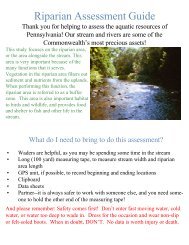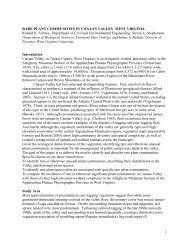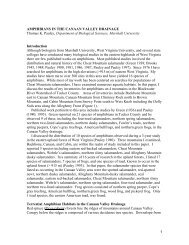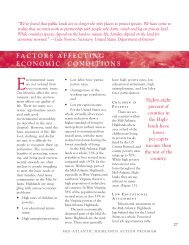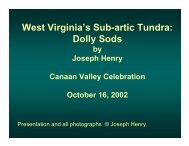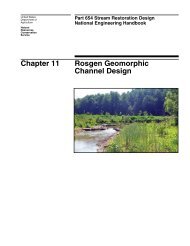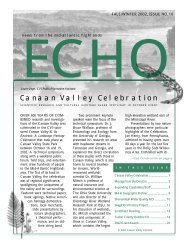1 PREHISTORY OF CANAAN VALLEY: AN ECOLOGICAL VIEW ...
1 PREHISTORY OF CANAAN VALLEY: AN ECOLOGICAL VIEW ...
1 PREHISTORY OF CANAAN VALLEY: AN ECOLOGICAL VIEW ...
You also want an ePaper? Increase the reach of your titles
YUMPU automatically turns print PDFs into web optimized ePapers that Google loves.
The prehistoric human animal was intimately connected to its patchy environment.<br />
His or her life revolved around exploiting some resources (e.g., knappable stone, hickory<br />
nuts, and white - tailed deer) and avoiding sites with limiting factors (e.g., cold rain, thick<br />
mosquitoes, raiding bands). Like other animals, people responded to this spatial and<br />
temporal heterogeneity by selecting a few places for long-term occupation while avoiding<br />
others.<br />
Canaan Valley lies in the unglaciated Allegheny Plateau subdivision of the<br />
Appalachian plateau physiographic province (Cremeens and Lothrop 2001). In such a<br />
region of steep-sided valleys, narrow valley bottoms, and plateau tops, the only habitable<br />
areas are stream valleys, benches, rock shelters, and ridgetops (Hasenstab and Johnson<br />
2001).<br />
An area with a floodplain, tributaries, and terraces, like along the Cheat River,<br />
seems to have represented an optimal habitat for prehistoric people (Gardner 1983, Fagan<br />
2000). In contrast, people may have perceived Canaan Valley as sub-optimal. The<br />
Valley's high elevation dictated cool air temperatures and a short growing season; its<br />
concave form and heavy precipitation supported a high water table and extensive<br />
wetlands; its tangled understory was hard to move through; the humid forest was too fireresistant<br />
to create ecotones for game species and sight lines for defense; and its rock<br />
outcrops offered no lithic sources.<br />
A second factor in Canaan Valley's slight use may have been its distance from<br />
population centers. Located in the mountainous interior away from primary trails (sensu<br />
Lane and Anderson 2001), Canaan Valley was a day's hike (about 20 straight-line km)<br />
from settlements in the Cheat and South Branch Potomac floodplains.<br />
A third reason for the Valley's low inhabitance is that prehistoric people may have<br />
rejected the "feel" of Canaan Valley. In many animals, innate predispositions (e.g.,<br />
Partridge 1974) and juvenile experiences (e.g., Wecker 1964) are important in forming<br />
adult habitat preferences. Perhaps innate factors provide the coarse tuning and learned<br />
factors the fine tuning in habitat selection. Young adult hunter-gatherers, raised in semiopen<br />
floodplain villages, may have disfavored Canaan Valley's thick structure and dark<br />
appearance. Perhaps they favored open woodland, i.e., a savannah-like habitat similar to<br />
that of our species' African origins.<br />
Even though prehistoric people may have shunned Canaan Valley for several<br />
reasons, the broad regional trends and specific local findings indicate they were in the<br />
Valley at least for brief visits. Why were they there at all?<br />
How prehistoric people used space can be viewed at several temporal scales.<br />
Annually, groups of people may have followed flushes of food, occupying a series of<br />
sites, each for an extended (e.g., 1-2 months) period. At the daily scale, people may have<br />
left their long-term, but possibly overexploited settled areas, hiked to distant places to<br />
hunt and gather, and then returned quickly (e.g., 1-2 days) with a load.<br />
Annual migrations<br />
Along the Shenandoah River in northern Virginia, the Flint Run complex was<br />
intermittently occupied by Clovis people after 11,500 YBP; the site then exhibits a<br />
cultural continuum from Paleo-Indian into the Archaic (Gardner 1974, 1977, 1986). This<br />
floodplain base camp included living areas with favorable wind and sun, and a place<br />
where local jasper was fashioned into tools.<br />
9





